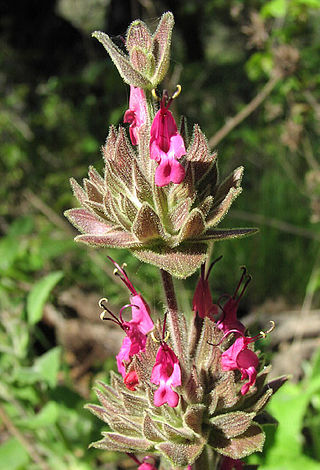
Salvia spathacea, the California hummingbird sage or pitcher sage, is a species of flowering plant in the family Lamiaceae, native to southern and central California growing from sea level to 610 m (2,001 ft). This fruity scented sage blooms in March to May with typically dark rose-lilac colored flowers. It is cultivated in gardens for its attractive flowering spikes and pleasant scent.

Ulmus uyematsuiHayata, commonly known as the Alishan elm, is endemic to forests at elevations of 800–2,500 metres (2,600–8,200 ft) in Alishan, Chiayi County, central Taiwan, where it is considered one of the minor tree species. The tree was first named and described by the Japanese botanist Bunzō Hayata in 1913, in the aftermath of the First Sino-Japanese War, when the Republic of Formosa was ceded to Japan.

Podocarpus nakaii is a species of conifer in the family Podocarpaceae. It is endemic to Taiwan, scattered in broad-leaf forests in the central part of this island. Ponesterone, which is similar to insect's moulting hormone ecdysone, is obtained from this plant. It was the first ecdysone isolated by Nkanishi et al.
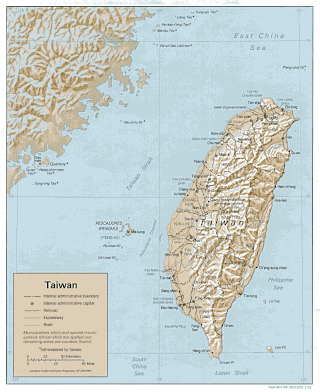
The flora of Taiwan is rich and varied due to the island's diverse geography and climate zones. The main island is situated on the Tropic of Cancer between China and the Philippine Sea basin. There are mountains in the east, running north and south on two-thirds of the island, with many peaks over 10,000 feet in elevation, and lower, flatter, and more fertile land to the west. The tropical climate, plentiful rainfall, and wide altitudinal range make for abundant and varied vegetation. Taiwan is home to over 4300 species of vascular plants, of which it is estimated that 600 are ferns, 28 are gymnosperms, 2400 are dicots, and 1000 are monocots.

Pyrenaria buisanensis is a species of tea endemic to Taiwan. It was first described by the Japanese botanist S. Sasaki in 1931, but the herbarium specimens were lost and the species identity remained dubious until a 2004 publication that reported its rediscovery and reclassified it as a species of Pyrenaria. Its status remains controversial, with some sources including it in Pyrenaria microcarpa as P. microcarpa var. ovalifolia.

Acer kawakamii is an Asian species of maple, found only in Taiwan. The species is sometimes confused with another Taiwanese tree, Acer morrisonense. This species has been known to reach 20 metres tall. Leaves are non-compound, the blade narrowly ovate, up to 11 cm long by 4.5 cm wide, with serrate margins but no lobes.

North American azaleas are flowering shrubs in the genus Rhododendron, section Pentanthera, subsection Pentanthera, so named because they all have five stamens. Most are in the United States, with one species found in Canada and one being found in Mexico. North American azaleas are commonly confused with azaleas of Asian origin, the evergreen azaleas. North American azaleas are deciduous and produce two types of buds. One is a larger and produces about 20 flowers while the other bud produces a leafy shoot. The flower color, fragrance, and number of stamens vary among species.
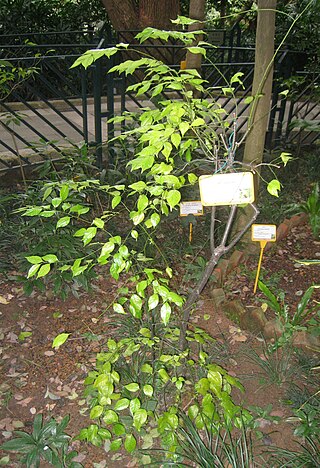
Ilex asprella, also known as rough-leaved holly and plum-leaved holly, is a deciduous shrub native in South East Asia. Ilex asprella is one of the few deciduous species in the family Aquifoliaceae.

Hibiscus taiwanensis, or the Taiwan cotton rose, is a native plant in Taiwan, which lives in China and low altitude in Taiwan. It is a species of plant in the Malvaceae family. The form of flower is different from Hibiscus mutabilis in China, which is double. It can attract butterflies.
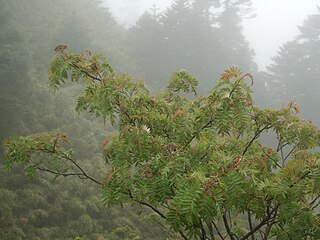
Sorbus randaiensis is a species of deciduous tree in the family Rosaceae. It is endemic to the mountain areas of central Taiwan, with altitude 1,800m to 3,200m, mostly spotted in the forest of Xueshan, Hehuan Mountain, Mount Xiluan, and Nenggao Mountain. It is a tree 3–8 m tall with white flowers and reddish fruit.

Berberis morrisonensis, commonly known as Yushan barberry (Chinese:玉山小檗) or red fruit barberry (Chinese:红果小蘖、赤果小蘖) is a perennial deciduous shrub belonging to the genus Berberis and endemic to Taiwan.

Rhododendron pachysanthum, the thick-flowered rhododendron, is a species of flowering plant in the heath family Ericaceae, that is native to Taiwan. It is an evergreen shrub growing to 2.5 m (8.2 ft) tall and broad. This species is particularly noted for its 9 cm (3.5 in) leaves, which may be heavily felted on both surfaces, red above and brown beneath. In early spring, trusses of pale pink flowers appear, spotted crimson on the inner surface.
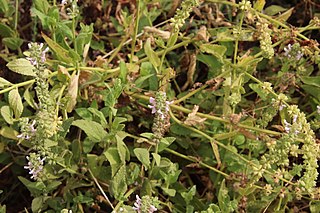
Stachys stebbinsii is a species of perennial herb in the mint family commonly known as Stebbins' hedgenettle. This plant is characterized by a musky aroma, flowers with large lower lips, and glandular hairs that densely cover the stems. S. stebbinsii is native to California and northwestern Baja California. It is usually found growing in moist places in a wide variety of habitats including disturbed areas, chaparral, coastal sage scrub and mountains.
Piper kawakamii, also known as the Kawakamii pepper, is a flowering plant in the family Piperaceae. It is a native endemic species in Taiwan. The plant is mainly distributed in the Hengchun Peninsula. It was collected by Takiya Kawakami at the Kuraru Community, on July 2, 1906. In 1911, the plant was published by Bunzō Hayata as a new species. The type specimen of this plant is being preserved in the Botanical Gardens, Graduate School of Science, the University of Tokyo, Japan.and the Herbarium of Taiwan Forest Research Institute
Lonicera kawakamii, also known as Yushan honeysuckle or Kawakami’s honeysuckle, is a species of flowering plant in the family Caprifoliaceae. It is endemic to Taiwan, where it is found at altitudes between 3000 and 3900 meters. It as rated as “Vulnerable” in the “Red List of Vascular Plants of Taiwan, 2017”.
Rubus swinhoei is also known as Swinhoe's raspberry, wood berry, Keelung rubus, Jingbai rubus and Libai rubus. It belongs to the genus Rubus of the family Rosaceae and is named after Robert Swinhoe for his contributions to Taiwan’s fauna and flora.

Youngia japonica subsp. formosana is an endemic subspecies of Youngia japonica in Taiwan. It is often confused with another endemic subspecies of Youngia, Y. japonica subsp. monticola. Collection records of this species dated back to 1906, but its taxonomy rank was not clarified until 2012. It is now known that this species is distributed primarily in the western coastline of Kaohsiung’s Shou-shan Mountain, Chihou Mountain and Liuqiu Island of Pingtung. The species normally grows on coastal coral-reef limestone rocks, and is morphologically distinctive from other subspecies by having a smaller plant, thicker and velvet-like textured leaves, and reddish-brown colored achene. The 2017 Red List of Vascular Plants in Taiwan evaluated the threat level of this species as “Least Concern” (LC).
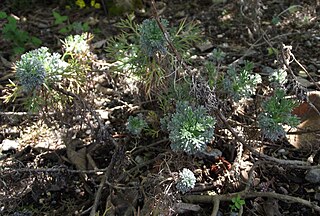
Artemisia kawakamii, commonly known as Kawakami's mugwort, is a plant in the Artemisia genus under the Asteraceae family that is endemic to Taiwan. The plant is distributed on the Taiwan island, growing at elevations from 2,700 to 3,300 m. It is commonly found in gravelly, open, and arid slopes. The species has yet to be cultivated.

Sedum sekiteiense is a Taiwan-endemic species of the family Crassulaceae in the Sedum genus. It is also one of the few wild plants named after Shiding. The species was first published by Yoshimatsu Yamamoto in 1934 in the Supplementa Iconum Plantarum Formosanarum. Although its taxonomic status has been stable, little is known about its ecological habits due to its rarity, limited distribution, and habitats that are often located on steep and inaccessible cliffs that are difficult to observe. The species is classified as “Vulnerable (VU)” in “The Red List of Vascular Plants of Taiwan, 2017.”
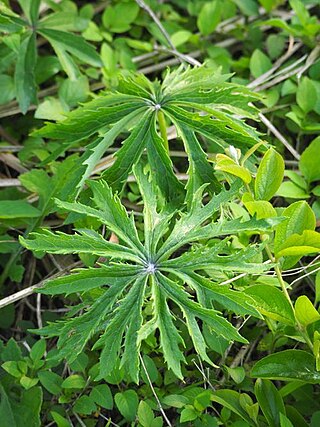
Syneilesis hayatae is one of two Taiwanese endemic plants in the genus Syneilesis, it is known as the Taiwan rabbit umbrella. Compared to the relatively stable population of Syneilesis subglabrata, this species was once thought to be extinct due to the lack of collection records for over half a century after World War II. In 2008 that the species was rediscovered in the lowland grasslands of Miaoli. Due to its small population size, the species was listed as “Critically Endangered (CR)” in the “Red List of Taiwan Vascular Plants, 2017.”

















